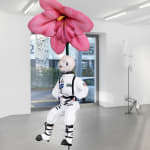Miriam Laura Leonardi
Angels of Chaos 1, 2016
Mixed media
230 x 100 x 80 cm
90 1/2 x 39 3/8 x 31 1/2 in
90 1/2 x 39 3/8 x 31 1/2 in
Further images
The artists she is thinking about when making her new sculptures, Miriam calls them by their first names: Meret, Isa, Lutz. On a hot summer day, in her studio, she...
The artists she is thinking about when making her new sculptures, Miriam calls them by their first names: Meret, Isa, Lutz. On a hot summer day, in her studio, she told me she liked it better that way, partly because family names are inherited from the father or acquired from the husband, enforcing a form of patriarchy that doesn’t interest her. I thought about my own name, a double one, both inherited and acquired from male individuals. I also thought about Lutz Bacher’s possibly masculine name and the kind of anonymity or neutral identity she is or was seeking by adopting this chosen name, or pseudonym as they say. But of course we all know Lutz Bacher is a woman... The flowers in Miriam’s studio are certainly not genderless, but they are also anonymous in the sense that Miriam doesn’t really care to identify the kind of flower they are, or to make them resemble any existing flower.
In Miriam’s sculptures the women, whose faces are also covered, or whose faces are flowers, are dressed in working attire. Their profession is astronaut or actress or columbine or the more generic “worker” with its orange overall. When we met during that hot summer day, we spoke about actresses, dancers, the music-hall, the theater, and about a film whose title forecloses the family names of its two protagonists: Céline et Julie vont en bateau. Céline (or maybe it is Julie) is a music-hall actress and dancer. At some point in the film, Julie has to get on stage to play Céline’s part, because Céline is away somewhere dealing with very important matters and she can’t work. Julie covers her face for quite a long time before revealing it to her audience and unveils she’s not the one they think. But they probably didn’t need to see her face to find out she wasn’t the one she pretended to be. Or did they? This makes her whole performance quite arousing, only her body is to be seen under bright theater lights: long legs, fancy shoes, high waist, red hair...
Céline and Julie keep swapping (or confusing) identities and roles throughout the whole film, and it feels like a possible definition of friendship. Friendship is often not about publicly declared admiration, or singing a tribute, but about being able to not be perfectly recognizable or differentiable from the loved one anymore. If I may risk here yet another definition of something (it is corny I know, to try to define such things) Miriam’s exhibition is like a reunion of friends who have been playing the game of confusing personalities for quite a long time now. Lutz, Meret and Isa reunited. In the midst of all this, Miriam’s face, the only human face to be seen here -or maybe not to be masked, or covered- is morphing owing to a fairly simple device: a sheet of plastic mirror cut in the shape of one of Jeff’s flowers...
Miriam, Meret, Isa, Lutz, Jeffery, Riri, Guwop, Kanye, Harembe, Rita, Bob, Lady, Geisha, Astronaut, Columbine, Actress, Worker, Céline, Julie, Jeff, Miriam.
Lili Reynaud Dewar
In Miriam’s sculptures the women, whose faces are also covered, or whose faces are flowers, are dressed in working attire. Their profession is astronaut or actress or columbine or the more generic “worker” with its orange overall. When we met during that hot summer day, we spoke about actresses, dancers, the music-hall, the theater, and about a film whose title forecloses the family names of its two protagonists: Céline et Julie vont en bateau. Céline (or maybe it is Julie) is a music-hall actress and dancer. At some point in the film, Julie has to get on stage to play Céline’s part, because Céline is away somewhere dealing with very important matters and she can’t work. Julie covers her face for quite a long time before revealing it to her audience and unveils she’s not the one they think. But they probably didn’t need to see her face to find out she wasn’t the one she pretended to be. Or did they? This makes her whole performance quite arousing, only her body is to be seen under bright theater lights: long legs, fancy shoes, high waist, red hair...
Céline and Julie keep swapping (or confusing) identities and roles throughout the whole film, and it feels like a possible definition of friendship. Friendship is often not about publicly declared admiration, or singing a tribute, but about being able to not be perfectly recognizable or differentiable from the loved one anymore. If I may risk here yet another definition of something (it is corny I know, to try to define such things) Miriam’s exhibition is like a reunion of friends who have been playing the game of confusing personalities for quite a long time now. Lutz, Meret and Isa reunited. In the midst of all this, Miriam’s face, the only human face to be seen here -or maybe not to be masked, or covered- is morphing owing to a fairly simple device: a sheet of plastic mirror cut in the shape of one of Jeff’s flowers...
Miriam, Meret, Isa, Lutz, Jeffery, Riri, Guwop, Kanye, Harembe, Rita, Bob, Lady, Geisha, Astronaut, Columbine, Actress, Worker, Céline, Julie, Jeff, Miriam.
Lili Reynaud Dewar











